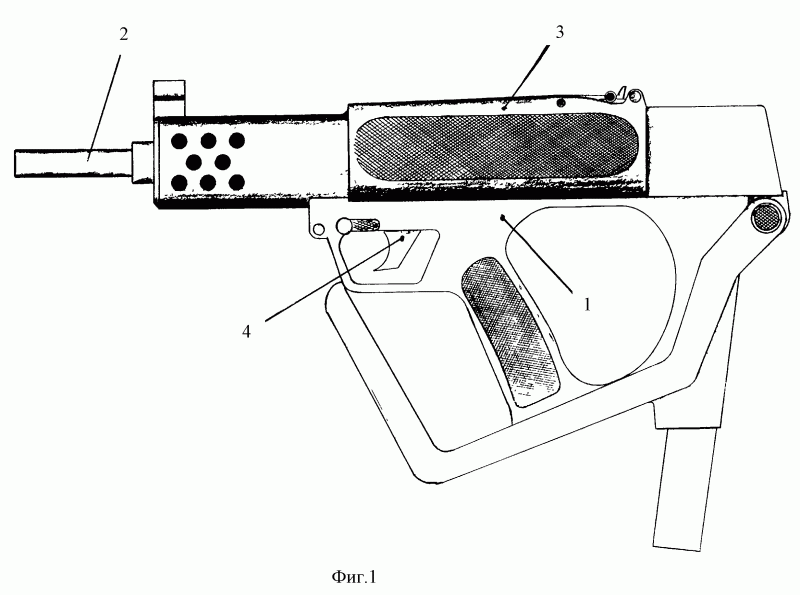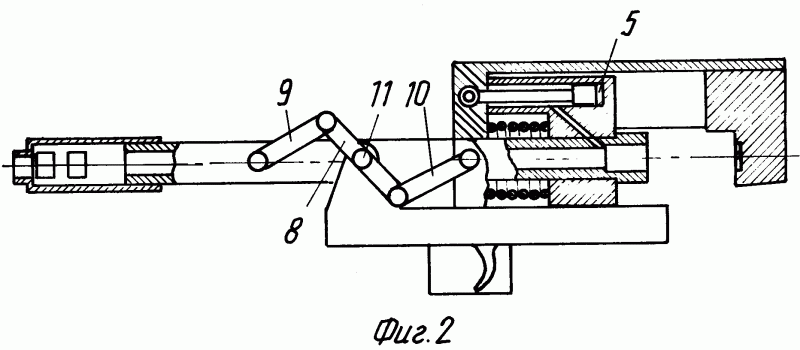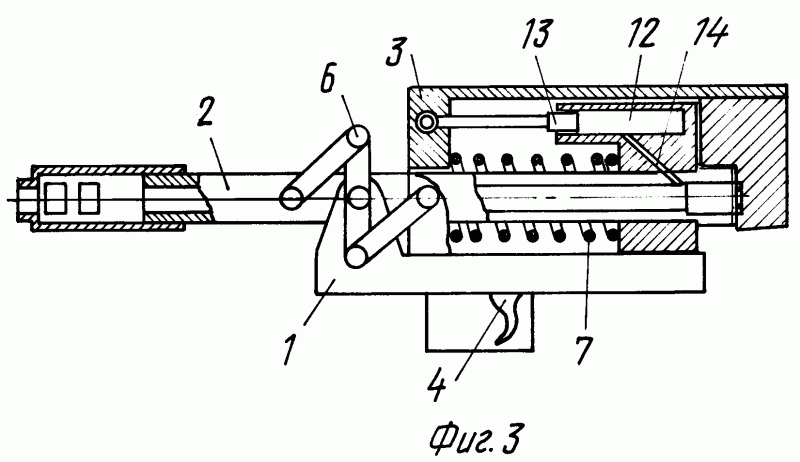Balanced automatics of the system I.Yu. Artemyeva and Yu.E. Ashurova
Artemyev and Ashurov offered a submachine gun with balanced automatics of the original design. When creating a new system, designers relied on the need to reduce or even completely quench the pulses affecting the weapon during firing. It was proposed to do this by reducing the action of the moving parts of the automation on the body of the weapon. An additional objective of the project was to simplify the design.
To solve this problem, the designers proposed to equip the prospective submachine gun not only with a movable gate, but also with a movable barrel. These parts must have the same mass and be connected to each other through a special mechanism of opposite motion. The mechanism consists of a "bloodworm" (swinging on the axis of the rocker) and two connecting rods pivotally connected with it. The connecting rods should connect the "bloodworm" with the barrel and bolt. The design of the mechanism is such that when the bolt moves backwards, the opposite connecting rod pushes the barrel forward and vice versa. Between the barrel and the bolt, it is proposed to place a return spring simultaneously acting on both these parts. When the bolt and barrel are in extreme positions, the spring is fully compressed.
In addition, in the design of the Artemyev and Ashurov submachine gun there is an original barrel locking system designed to hold it in place during the shot and reduce its speed of movement. In the breech breech gas chamber is provided, which includes a piston rigidly connected with the gate. The gas chamber, in turn, is connected with the breech breech: the gas outlet is located directly in front of the chamber. During the shot, the powder gases enter the chamber, their pressure at this moment is too high to allow the piston to quickly enter the chamber. Due to this, the movement of the shutter should slow down.
The design of the firing mechanism is not described. The inventors proposed only the original principle of the automation with the repayment of the recoil momentum. At the same time, the general scheme of the prospective weapon is attached to the patent. Thus, the pistol grip fire control with a trigger and protective bracket should be located under the middle part of the receiver. The reception shaft of the store was proposed to be placed in the rear of the weapon, due to the design features of the applied automation.
The work of the original automation is as follows. In the cocked and ready to fire weapon, the bolt and barrel are in extreme positions and are held by the return spring. When you press the trigger spring returns the barrel and bolt in the center position. In this case, the back of the bolt hooks the cartridge from the magazine and sends it to the chamber. Drummer, placed on the gate, hits the primer and there is a shot. Powder gases through the gas outlet enter the gas chamber. Their pressure does not allow the piston to enter the chamber and thus slows down the displacement of the shutter under the action of recoil. After the bullet leaves the barrel, the pressure in the gas chamber drops, due to which the recoil can move the bolt to the extreme rear position. At the same time, the trunk is transferred to the frontmost position and the return spring is compressed. The cycle is completed, the weapon is ready for a new shot.
The bolt and barrel of the Artemyev and Ashurov design submachine guns have the same mass, which accordingly affects the parameters of their movement. Receiving recoil energy, these parts should diverge in different directions with the same speed. Thus, the pulse gate and the barrel are the same in magnitude, but opposite in direction. Due to this, the recoil impulse is extinguished. Accuracy and accuracy of shooting improves.
Like any other invention, the balanced automation of Artemyev and Ashurov has pros and cons. The first should include the very possibility of damping the recoil pulse. Another plus of the proposed design is visible in comparison with other systems of balanced automation. For example, the Russian AEK-971, AK-107 and AK-108 automatic machines use a special movable balancer to absorb recoil. This detail, by compensating for the pulse of the bolt, increases the overall weight of the weapon. In the Artemyev and Ashurkov system, the barrel plays the role of a balancer. Thus, the number of parts in the proposed submachine gun is reduced to the required minimum.
At the same time, the proposed system of balanced automation has a noticeable disadvantage, directly related to its design. A special mechanism based on levers and a rocker arm is used to set the barrel in motion. Such a system can reduce the stability of the mechanics in conditions of pollution. In addition, the mechanism of the opposite movement may impose special requirements on the accuracy of production of parts.
When creating weapons based on automatics I.Yu. Artemyeva and Yu.E. Ashurov designers will have to solve several serious problems. The main difficulty is to ensure the correct combination of masses of various parts and forces acting on them. The design of the weapon should be designed in such a way that the pressure of the powder gases of the cartridge is enough to lock the bolt for some time; and the recoil energy must be large enough to move both the bolt and the barrel. The latter task can be solved by alleviating these details, but a reduction in the mass of the trunk may affect its strength.
With all the flaws and ambiguous features, the design of Artemyev and Ashurov balanced automation is of great interest. The inventors were able to offer their original solution to the old problem, which does not lead to a significant complication or weighting of weapons. In addition, they managed to reduce the number of parts to the required minimum and thereby simplify the design. However, as far as we know, for almost a half decade since the issuance of the patent RU 2152582, a new idea has not received further development. Information on the development of weapons based on the automation of Artemyev and Ashurov is not available. Apparently, gunsmiths are not interested in the proposal of the inventors.
Based on:
http://findpatent.ru/patent/215/2152582.html



Information